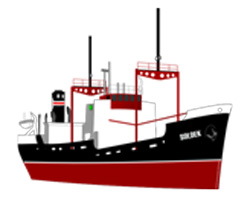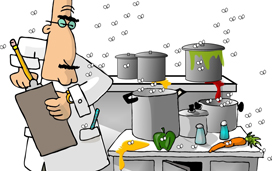Fumigation
Certification

Fumigation is a method of pest control that completely fills an area with gaseous pesticides to suffocate or poison the pests within. It is utilized for control of pests in buildings (structural fumigation), soil, grain, and produce, and is also used during processing...
Read More
Fumigation is a method of pest control that completely fills an area with gaseous pesticides to suffocate or poison the pests within. It is utilized for control of pests in buildings (structural fumigation), soil, grain, and produce, and is also used during processing of goods to be imported or exported to prevent transfer of exotic organisms. Structural fumigating techniques differ from building to building, but in houses a rubber tent is often placed over the entire house while the pesticides are being released into the residence.
This concentrates the gases and prevents them from escaping and doing harm to people in the neighbourhood. During this time the residents of the house must find an alternate residence for up to a week depending on the fumigant used, which in turn depend on the severity of infestation and size of the house.
Methyl bromide was among the most widely used fumigants until its production and use was restricted by the Montreal Protocol due to its role in ozone depletion.
Widely used fumigants include:
- Phosphine
- 1,3-Dichloropropene
- Chloropicrin
- Methyl Isocyanate
- Hydrogen Cyanide
- Sulfuryl Fluoride
- Formaldehyde
Fumigation is a hazardous operation, and generally it is a legal requirement that the operator carrying out the fumigation operation holds official certification to perform the fumigation. Fumigation usually involves the following phases. First the area to be fumigated is usually covered to create a sealed environment; next the fumigant is released into the space to be fumigated; then, the space is held for a set period while the fumigant gas percolates through the space and acts on and kills any infestation in the product, next the space is ventilated so that the poisonous gases are allowed to escape from the space, and render it safe for humans to enter.
The correct ventilation of the area is a critical safety aspect of fumigation. It is important to distinguish between the pack or source of the fumigant gas and the environment which has been fumigated. While the fumigant pack may be safe and spent, the space will still hold the fumigant gas until it has been ventilated.
HACCP
Certification

Hazard Analysis and Critical Control Points (HACCP) is a systematic preventative approach to food safety and pharmaceutical safety that addresses physical, chemical, and biological hazards as a means of prevention rather than finished product inspection...
Read More
Hazard Analysis and Critical Control Points (HACCP) is a systematic preventative approach to food safety and pharmaceutical safety that addresses physical, chemical, and biological hazards as a means of prevention rather than finished product inspection. HACCP is used in the food industry to identify potential food safety hazards, so that key actions, known as Critical Control Points (CCP's) can be taken to reduce or eliminate the risk of the hazards being realized. The system is used at all stages of food production and preparation processes including packaging, distribution, etc.
HACCP helps to prevent, as close to 100 percent as possible, harmful contamination in the food supply.
- Analyze hazards. Potential hazards associated with a food and measures to control those hazards are identified. The hazard could be biological, such as a microbe; chemical, such as a toxin; or physical, such as ground glass or metal fragments.
- Identify critical control points. These are points in a food's production from its raw state through processing and shipping to consumption by the consumer at which the potential hazard can be controlled or eliminated. Examples are cooking, cooling, packaging, and metal detection.
- Establish preventive measures with critical limits for each control point. For a cooked food, for example, this might include setting the minimum cooking temperature and time required to ensure the elimination of any harmful microbes.
- Establish procedures to monitor the critical control points. Such procedures might include determining how and by whom cooking time and temperature should be monitored.
- Establish corrective actions to be taken when monitoring shows that a critical limit has not been met--for example, reprocessing or disposing of food if the minimum cooking temperature is not met.
- Establish procedures to verify that the system is working properly for example, testing time-and-temperature recording devices to verify that a cooking unit is working properly.
- Establish effective record keeping to document the HACCP system. This would include records of hazards and their control methods, the monitoring of safety requirements and action taken to correct potential problems. Each of these principles must be backed by sound scientific knowledge: for example, published microbiological studies on time and temperature factors for controlling foodborne pathogens.
Advantages
HACCP offers a number of advantages over the current system. Most importantly, HACCP focuses on identifying and preventing hazards from contaminating food is based on sound science permits more efficient and effective government oversight, primarily because the recordkeeping allows investigators to see how well a firm is complying with food safety laws over a period rather than how well it is doing on any given day places responsibility for ensuring food safety appropriately on the food manufacturer or distributor helps food companies compete more effectively in the world market reduces barriers to international trade.Ship Sanitation Control/Exemption Certification

The Public Health (Ships) (Amendment) (England) Regulations 2007 came into force on 15th June 2007. These regulations implement the requirement of the International Health Regulations 2005 and as a result, the former Deratting Certificate have been...
Read More
The Public Health (Ships) (Amendment) (England) Regulations 2007 came into force on 15th June 2007. These regulations implement the requirement of the International Health Regulations 2005 and as a result, the former Deratting Certificate have been replaced by Ship Sanitation Control Exemption Certificate/Ship Sanitation Control Certificate.
The new certificate will involve a more detailed inspection, which will include checks for vectors of illness and controls in place to minimise the risk of the spread of any illness. If the inspection reveals no evidence of a risk to public health, a Ship Sanitation Control Exemption Certificate will be issued which will be valid for 6 months.
Should evidence of infection or contamination be found, including: vectors in all stages of growth; animal reservoirs for vectors; rodents or other species that could carry human disease, microbiological, chemical and other risks to human health; signs of inadequate sanitary measures. A Ship Sanitation Control Certificate will be issued outlining the vector or reservoir and treatment undertaken.
Before staff can inspect a vessel for the purpose of undertaking a Ship Sanitation inspection the following information should either be emailed or faxed.
- Port where the vessel will be inspected
- Name of ship
- Flag or state registered
- Registration/IMO number
- Gross tonnage
- The last set of microbiological water results must also be forwarded before an inspection can commence.

We can take and submit drinking water/ice/swimming pool water samples for bacteriological examination on request. There will generally be a small charge for this service and a laboratory report will be provided together with a certificate.
Requests for inspection should be made to Pestman Pest Management Services by e-mail to doctor@pestmaservices.com
Implementation of Ship Sanitation Control Exemption Certificate/Ship Sanitation Control Certificate
How to?
Articles 20, 27 39 and Annex 3 of IHR (2005)

15 June 2007 is the date that the International Health Regulations (2005) (IHR (2005)) will enter into force. Among the provisions that apply to conveyances is a new Ship Sanitation Control Exemption Certificate/Ship Sanitation Control Certificate SSCEC/SSCC, a model of which is shown in Annex 3. These certificates will replace the De-ratting Certificate/De-ratting Exemption Certificate (DC/DEC) issued under IHR (1969) .
The latest date that a De-ratting Certificate can be issued is one day prior to the entry into force of IHR (2005) or 14 June 2007. A De-ratting Certificate issued on that date is valid for a maximum of six months, or until 14 December 2007. During the six month period from 14 June to 14 December 2007 both unexpired DC/DEC and newly issued SSCEC/SSCC will be in use. After 15 December 2007 no De-ratting Certificate will be valid.
As of 15 June 2007 if evidence of a public health risk is found on board a ship and the ship is not able to produce a valid DC/DEC or SSCEC/SSCC, the competent authority may proceed to inspect the ship with one of three possible outcomes.
1) No evidence of a public health risk is found on board. The competent authority may issue a SSCEC.
2) Evidence of a public health risk is found on board. The competent authority satisfactorily completes or supervises the completion of the necessary control measures and is required to issue a SSCC. If, in the opinion of the competent authority, the conditions under which control measures are carried out at the port are such that a satisfactory result cannot be obtained, this should be noted on the existing SSCC. The SSCC is valid for a maximum period of 6 months. The control measures must be completed before a further SSCC is issued.
3) The competent authority extends the SSCEC for a period of one month until the ship arrives at a port at which the Ship Sanitation Control Certificate may be received.
States Parties shall send to WHO a list of ports authorized to offer:
1) the issuance of SSCC and the provisions referred to in Annexes 1 and 3;
2) the issuance of the SSCEC only and,
3) the extension of the SSCEC. State Parties shall inform WHO of any changes which may occur in the status of the listed ports.
States Parties may wish to consider publishing any interim transition arrangements for the Annex 3 certificates (on the web or elsewhere).
Under Article 41 any tariff (or amendment thereto) for applying health measures to baggage, cargo, containers, conveyances, goods or postal parcels (and for measures applied to travellers under Article 40) have to be published at least 10 days in advance of any levy.
In order to facilitate international marine traffic, WHO advises that the Sanitation Control Exemption Certificate/Ship Sanitation Control Certificate in Annex 3 of IHR (2005) be printed and completed in English and/or in French, and may also be completed in another language on the same document in addition to either English or French.
 UAE
UAE





